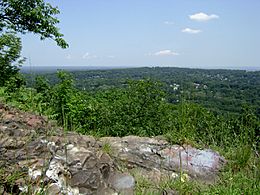Preakness Range facts for kids
Quick facts for kids Preakness Range |
|
|---|---|
| Watchung Mountains | |

Goffle Hill can be seen across a valley from a ledge near the summit of High Mountain in Wayne, New Jersey.
|
|
| Highest point | |
| Peak | High Mountain |
| Elevation | 879 ft (268 m) |
| Dimensions | |
| Length | 11 mi (18 km) northwest–south |
| Geography | |
| Country | United States of America |
| Geology | |
| Age of rock | Triassic and Jurassic |
| Type of rock | extrusive igneous and trap rock |
The Preakness Range is a group of mountains in northern New Jersey. It's part of the larger Watchung Mountains and is known for its unique rock formations called trap rock. A big part of this area is now High Mountain Park Preserve, which has many trails for hiking. From these trails, you can see amazing views of New Jersey and even New York City. The Preakness Range has the highest peaks in the Watchung Mountains. It's also home to special natural areas, like wetlands and rare plant communities.
Contents
Where is the Preakness Range?
The Preakness Range usually refers to the peaks of Preakness Mountain. This is a section of the Second Watchung Mountain, located north of the Passaic River. Sometimes, Packanack Mountain, which is part of the Third Watchung Mountain, is also included.
Goffle Hill is another nearby mountain. It's part of the First Watchung Mountain. While it's close by, it's usually not considered part of the Preakness Range itself.
Highest Peaks of the Range
Preakness Mountain starts in Totowa, New Jersey. It curves north and then west, ending near Oakland, New Jersey. The three tallest peaks of the Watchung Mountains are found here. They are all located in Wayne, New Jersey.
Mount Cecchino is the lowest of these three peaks. It rises to 755 feet (230 meters). Immediately north of it is High Mountain, which reaches 879 feet (268 meters). This makes High Mountain the tallest peak in all the Watchung Mountains. Northwest of High Mountain is Beech Mountain, which is 869 feet (265 meters) tall. It is the second highest peak in the Watchungs.
History of the Preakness Range
The Preakness Range was originally home to the Munsee (Minsi) Lenape people. Their heritage lives on in the name of the range. The word Preakness comes from per-ukunees. This Lenape term is thought to mean young buck, referring to a young male deer.
For a time, Dutch settlers called the range Harteberg. This name also means Deer Mountain.
Revolutionary War Lookout
Like most of the Watchung Mountains, the Preakness Range was used as a lookout during the American Revolutionary War. In October and November of 1780, General Arthur St. Clair’s soldiers camped at the base of the mountain. They likely used its height to watch for enemy movements.
Protecting the Wilderness
For many years, the Preakness Range remained a wild area. It offered a place for people from nearby towns to enjoy nature. Only the southern part of the range saw much building. William Paterson University helped keep development from spreading further north.
In the 1980s, new buildings started to threaten the wild areas. Local people began to work hard to protect the Preakness Range. Their efforts led to the creation of High Mountain Park Preserve. This preserve helps keep the beautiful wilderness safe for everyone.
How the Preakness Range Formed
The Preakness Range was created about 200 million years ago. This happened when hot, melted rock flowed out onto the Earth's surface. At that time, the area was part of a large valley. This valley stretched through northern and central New Jersey and into Pennsylvania.
Later, the valley stopped growing. Over time, softer rocks like sandstone and shale wore away. This left behind the harder basalt lava flows of Preakness Mountain and Packanack Mountain. That's how the mountains became elevated.
Unique Valleys
An interesting feature of the Preakness Range is its valleys. These valleys run north and south, creating two main sections. They formed because of three separate volcanic eruptions. Each eruption laid down a sheet of lava, creating three ridges. These ridges together form the main part of the Preakness Range.
The ridges get shorter from east to west. This matches the order in which the lava flows happened. The easternmost ridge was formed first, and it is the tallest.
Wildlife and Plants of the Preakness Range
The Preakness Range is a very important natural area. It has many different types of wild spaces. The New Jersey National Heritage Program has given it a high rating for its amazing variety of living things. This means it has very high biodiversity.
Nine different types of natural communities have been found here. These include rare trap rock glade communities and hickory-ash red cedar woodlands.
Rare Plants and Animals
Seven plant species that are endangered in New Jersey live in the Preakness Range. One of these, Torrey's mountain mint (Pycnanthemum torrei), is endangered worldwide. Twelve other rare plants also grow in the forests and wetlands of the range.
Some rare plants grow here because of special minerals in the trap rock. These minerals can make the soil less acidic. This helps certain plants grow that might not survive in the more acidic soils nearby.
The mountains of the Preakness Range also provide important homes for many animals. For example, about sixty different kinds of birds are thought to breed in the various habitats found in the range.

